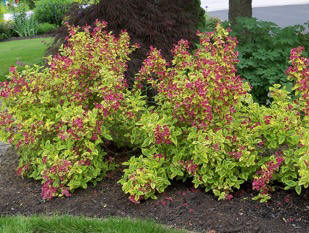|
|

|
|
Reasons flowering shrubs donít bloom
Barbara Mrgich
Adams County Master Gardener
 (7/3)
Gardeners often are in a quandary about why their flowering shrubs are not blooming as they should. Like so many gardening questions, there is no one answer. However, there are numerous factors that influence plant bloom, and sometimes the gardener just has to play detective, look for clues, and try to solve the mystery. In order to do that, you need to know the answers
to some specific questions: (7/3)
Gardeners often are in a quandary about why their flowering shrubs are not blooming as they should. Like so many gardening questions, there is no one answer. However, there are numerous factors that influence plant bloom, and sometimes the gardener just has to play detective, look for clues, and try to solve the mystery. In order to do that, you need to know the answers
to some specific questions:
- What is the botanical name of this plant? - Knowing exactly what you have is crucial to knowing what to do when problems arise. ALWAYS KEEP THE PLANT TAG along with any other information you can fine about the plant. When problems arise, you will be able to look up the exact plant you have questions about.
- Is the plant in the wrong location? - Plants that require full sun will not bloom well in the shade. Maybe the site used to be sunny, but, over the years, it has now become more shadier than you realized.
- Is this plant under stress? - Stress will adversely affect flowering. Some factors that produce stress include: Soil too wet, or too dry. Not enough sun. Disease or Insect damage. Plant is planted too deep in the soil or has too much mulch. It needs fertilizer, has too much fertilizer, or has the wrong kind of fertilizer. (see question #9)
- 4. Does this plant bloom on old or new wood? - If the plant should bloom in the spring sometime between April and June, it probably blooms on "old wood". Google the name of the shrub to find out for sure. Old wood are the canes (stems) that were part of the shrub last year. These stems may look dead in early spring, but they are holding this yearís flower buds. If
you prune them in the fall or early spring, you are cutting off all your potential flowers. This is a problem for many shrubs, but is especially true of the older cultivars of big-leaf Hydrangeas, Lilacs, Forsythia, Azaleas, and Rhododendrums. Spring flowering shrubs should be pruned immediately after flowering, At that time you can trim them for height or shape, and
you should cut out some of the oldest canes. Prune the old canes off right at ground level (do a couple each year) and new, fresh canes will sprout keeping the plant young looking and vibrant.
- Does your shrub need to be rejuvenated? - Sometimes, if a shrub has lived for many years with no care, it will become very unattractive and nearly cease flowering. Cutting the entire shrub down to about 6" to 12" will force it to send up fresh new canes and renew vigorous blooming. Do this in February or March while the plant is dormant. Depending on the type of
shrub, you may sacrifice the blooms for one year, but it will be worth it.
- Is your shrub dioecious? - Most common garden and landscape plants have male and female parts on the same plant. Before a flower can be formed, the male pollen must reach the female ovum. This is usually accomplished by pollinators. Some trees and shrubs however, are dioecious meaning they are either male or female. The most common example of this is Holly. In
order to get berries on the female plant, you must also have a male plant somewhere in the not-too-distant vicinity. It cannot be just any male, it must be one in blooming sync with that particular female.
- Was this shrub recently transplanted? - When a plant is transplanted from one location to another (or from the nursery to your garden), much of the root system is damaged, and will require time to rebuild. How much time depends on the extent of the damage and the plant species. In the case of some larger shrubs, it could take a couple years before it will again
begin to bloom. Likewise, a young shrub newly started from seed or from a cutting can take a few years before it ever begins to bloom.
- How was the early spring weather? - Often, we get a nice warm-up period in February and March when flowering trees and shrubs begin to be lured into budding, only to be zapped by the return of freezing weather in April. The new buds are frozen, killing all hope of flowering for that year. This is especially troublesome with favorite plants like Hydrangea,
Magnolia, and Camellia.
- What fertilizer are you using? - Fertilizer can sometimes be the source of blooming problems. Your shrub may not be blooming because it lacks phosphorus, or, more likely, because it is getting too much nitrogen. Repeatedly fertilizing your lawn with a high nitrogen fertilizer may affect the flowering shrubs which grow close to the lawn by causing them to develop
lots of leaves and not many flowers.
Always do a soil test before applying fertilizer to anything. Many times you may not need any fertilizer, and adding more can adversely affect blooming. In addition, if excessive phosphorus is added, it can run off causing algae growth in streams and lakes.
Read other articles on shrubs and vines
Read other articles on garden and landscape design
Read other articles by Barbara Mrgich |
|
 |
 |
|
|
|